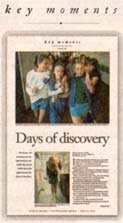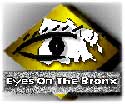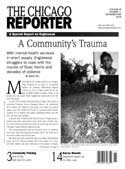
New Hampshire Tax Challenge, Concord, NH 1999
Partners:
An estimated 30,000 residents, or more than 4% of the state’s registered voters, used their computers to access the radio station’s online calculator to see how proposed new tax bills would affect them.
In addition, NHPR used the site as a reporting tool, monitoring a Feedback Zone and interviewing some of the respondents for radio stories about the personal impact of various tax proposals.
The nine-month project not only gave citizens the facts and figures they needed to participate in a public-policy debate, but brought a large online audience to the network’s Web site during daytime hours when its radio listener numbers are down.
Contact:
Jon Greenberg
Senior News Editor
New Hampshire Public Radio
207 North Main Street
Concord, NH 03301-5003
Phone: (603) 223-2435
Email: jgreenberg@nhpr.org

Aging Matters, Savannah, GA 1999
Partners:
The paper published an 11-part series on the issues faced by the region’s growing elderly population, beginning in September of 1999 and continuing through the summer of 2000. The coverage became a prime example of unraveling a community’s “master narrative.”
A Pew-supported survey of 740 Savannah-area residents helped frame the topics for “Aging Matters,” along with a series of small focus groups, each with about eight participants. The series explored how and why people age, health and long-term care, legal issues that arise as people age, the political impact of a growing senior population and the financial impact of aging.
Each installment included stories about people who’ve remained active and involved as they aged and found positive aspects to the process. The series also included resource guides on each issue explored and invited community participation in the conversation. Online message boards and chat rooms, special call-in lines and continued focus groups gave readers outlets to discuss problems and offer solutions.
The series inspired Savannah-area legislators and community groups to take action. After an installment on seniors who are primary caregivers to grandchildren, Savannah’s congressmen and state senator inaugurated a series of Saturday morning discussion groups to determine what services government could provide. Stories on nursing home care prompted the city’s state representative to introduce legislation requiring higher ratios of nursing home staff per patient. And senior citizens centers, advocacy groups and hospices reported an increase in volunteer help.
The series won the Batten Award in 2000.
Contact:
Dan Suwyn
Managing Editor
Savannah Morning News
PO Box 1088, 11 W. Bay St.
Savannah, GA 31402-1088
Phone: (912) 652-0322
Email: dsuwyn@savannahnow.com
Rexanna Lester
Executive Editor
Savannah Morning News
PO Box 1088, 11 W. Bay St.
Savannah, GA 31402-1088
Phone: (912) 652-0300
Email: rexanna@savannahnow.com

TeenGo Web Site and On the Verge, Portland, ME 1999
Partners:
After the shootings at Columbine High School, the newspaper invited teenagers from around Maine to write about what high school life is like today. In April of 1999, 20 essays were published in the newspaper and more than 150 were posted on the “teengo” page of the Press Herald’s Web site. The page also launched an interactive forum so teens from all over Maine could chat online and created 20below.com, a Web site for teens. The site attracted visits from about half the teenagers in the state.
In September, the paper distributed 60 disposable cameras to teenagers who came to a pizza night and asked them to chronicle their own lives so it could use the pictures to illustrate teenage life, as part of a series of newspaper stories, and on the Web site.
The essays and photos helped the paper select four communities where teenagers worked together to create their own Web site, using KOZ software, which eliminated the need to learn HTML.
Contact:
Jessica Tomlinson
Online Community Organizer
MaineToday.com
50 Monument Square
Portland, ME 04101
Phone: (207) 822-4072
Email: Jessica@mainetoday.com

Millenium Leadership Project, WA 1999
Partners:
The Front Porch Forum
The Seattle Times
KUOW-FM
The partners sought input from some 40 Seattle area citizens for a project exploring local leadership and what the consensus-loving region seeks in those who lead its public institutions. The partners hosted informal discussions with one group of people who head up leadership development programs and a second group of recognized leaders from Seattle’s communities of color. They also held two focus groups with residents to explore the topic.
The partners concluded that participants wanted leaders who show a willingness to take risks, creativity, confidence, commitment and humility. However, few participants could name any local leaders who embodied these traits or whom they felt were well qualified and positioned to lead the region in the future. Instead, they spoke of a lack of leadership on local issues, with more conservative participants believing the private sector was better equipped than the public sector to address these issues.
Reporters used the information to frame a series of stories that ran in The Times and on KUOW in the fall of 1999. The effort proved useful in covering breaking news, as well. When the Seattle police chief was forced to resign after protests disrupted the World Trade Organization meeting in 2000, the partners were able to report what the community was looking for in a new chief.
Contact:
Marion Woyvodich
1138 North 82nd Street
Seattle, WA 98103-4405
Phone: (206) 522-5754
Email: MWoyvodich@aol.com

Kids & Character 2000, Elmira, NY 1999
Partners:
The Star-Gazette’s focus on teaching values to children turned out to be eerily prescient. Just weeks after its series on the subject ran, two teenagers opened fire on classmates and teachers at Columbine High School in Colorado. The event gave the Star-Gazette’s project an added intensity, prompting more area school districts, chambers of commerce and non-profit agencies to pick up the call for character education.
The project began with two Pew-supported surveys – one of 1,000 Elmira-area junior and senior high school students; the other of 450 area adults – asking what values they felt were most important to the community. Responsibility, honesty, respect and tolerance were among the most highly valued traits. The survey results were reported in a front page story Sunday, March 14, 1999. Follow-up installments ran March 21 and 28-30.
The series was timed to coincide with local workshops given by character education specialist Louis Martinez. More than 200 people attended, many saying the newspaper series had persuaded them to go.
When Martinez returned in October, the Star-Gazette sponsored a community forum with parents, teachers, principals, counselors, police and judges on how to instill these traits in area youth.
Contact:
Jane E. Sutter (former Star-Gazette editor)
Managing Editor
Democrat and Chronicle
55 Exchange Blvd.
Rochester, NY 14614
Phone: (585) 258-2301
Email: jsutter@democratandchronicle.com

Target Transportation, Springfield, VA 1999
Partners:
The 24-hour, all-news station conducted a phone survey of 1,000 Washington, DC, area residents and found that traffic congestion is the most-often cited problem that impacts daily life. The survey also showed residents preferred developing more mass transit to building new roads as a way to deal with congestion but were generally pro-growth and optimistic about finding solutions.
The Pew-funded poll was mailed to 600 government and community leaders and became the focus for coverage of the issue throughout the year. Special programming included, in February 1999, a 2 1/2-hour live prime-time broadcast bringing together almost 100 citizens in three Washington area jurisdictions (Northern Virginia, Maryland and the District of Columbia) with elected officials and transit leaders including three congressmen, two state Secretaries of Transportation, two County Executives and executives of the Metro system.
Contact:
Wayne Lynch
Former VP News and Programming
NewsChannel 8
7600-D Boston Blvd.
Springfield, VA 22153
Phone: (703) 912-5339
Email: w76er@aol.com

Neighborhood News Network, Tampa, FL 1999
Partners:
Using a database of more than 300 community groups and media organizations, the Weekly Planet created an email “wire service” for community news to compliment the “Public Life” newsletter launched earlier with Pew support. Grass roots organizations would send the Planet staff news about what they were doing and, about once a week, the Planet would package those stories and send them out via email to some 650 subscribers. The hope was that the community groups would find out where they had projects in common and how they could work together, while at the same time their stories would receive attention from more mainstream media organizations.
As part of the project, journalism students from the University of South Florida and the University of Tampa were tapped to write up the best stories for the Weekly Planet. The partners also planned to use broadcast journalism students to produce a monthly “Neighborhood News Hour” on the public access cable station and were seeking further funding to cover production costs.
Contact:
Ben Eason
President and CEO
Creative Loafing
1310 E. 9th Avenue
Tampa, FL 33605
Phone: (813) 248-8888
Email: ben.eason@creativeloafing.com

Key Moments, Spokane, WA 1999
Partners:
A team of reporters and editors used (and helped refine) civic journalism “mapping” tools to chart the key moments in the lives of children that can make the difference between success and failure in adulthood. Building on its “City of Second Chances” project, which told the story of Spokane’s expanding ex-felon population and how prisons were not solving the problem of troubled people who are incarcerated, the newspaper wanted to answer the question: What would it take to change the lives of people who end up in prison?
The paper held four roundtable discussions with educators, police, religious leaders, counselors and others. That helped editors develop a list of 10 moments in life that are critical in affecting whether kids stray or stay on track. They include five chronological moments: conception to birth, birth to age 3 and the bonding process, age 10, the first day of 7th grade, and adolescent rites of passage such as driving, drinking and sex. There are also five developmental moments: making friends, major moves, times of loss, first failure and first success, and values development.
The Spokesman-Review then surveyed more than 70 teenagers, asking them to evaluate their own experiences in these key moments and where they found help getting through them. Reporter Jeanette White mined the community for children and young adults who exemplified these transitions.
The 10-part series “Key Moments,” published in the summer of 2000, included an overview of each key moment, intimate personal stories that put a human face on each one and boxes with tips and lists or resources – all drawn from this innovative use of mapping, focus groups and surveys. After the series ran, the paper held two community forums on the series that helped parents connect with specialists in the community for help during key moments.
Contact:
Chris Peck, (former Spokesman-Review editor)
Editor
The Commercial Appeal
P.O. Box 364
Memphis, TN 38101
Phone: (901) 529-2322
Rebecca Nappi
The Spokesman-Review
999 W. Riverside Ave.
Spokane, WA 99201
Phone: (509) 459-5496
Email: Rebeccan@spokesman.com

Harwood Civic Mapping Seminars, Denver, CO 1999
Partners:
The Harwood Institute
Pew Center for Civic Journalism
This series of three two-day seminars taught reporters and editors from six newsrooms how to improve their capacity to understand and interpret their communities, using the tools and techniques of civic mapping. Mapping helps journalists go beyond official and quasi-official sources of news by identifying and exploring other, less formal layers of civic life. The approach was first outlined by The Harwood Institute (formerly The Harwood Group) in “Tapping Civic Life: How to Report First and Best What’s Happening in Your Community,” a workbook based on 1994 research at The Wichita Eagle supported and published by the Pew Center.
The Harwood staff led the seminars. Participants included five newspapers and one television station.
The participants each selected areas to map and researched the nature and depth of their newsroom’s existing knowledge for those areas. They visited their target areas to interview a range of community leaders and citizens. The resulting maps varied widely in scope and format but each helped strengthen the newsrooms knowledge of the community.
The project proved so successful that the Pew Center published a second edition of “Tapping Civic Life,” to reflect the participants’ experiences. The center also partnered with the Harwood Group for several more seminars that eventually involved 24 news organizations across the country in civic mapping training.
Contact:
Richard C. Harwood
President
Harwood Inst. for Public Innovationbr> 4915 St. Elmo Ave, Suite 402
Bethesda, MD 20814
Phone: (301) 656-3669
Email: rharwood@theharwoodinstitute.org
Jan Schaffer
Executive Director
Pew Center for Civic Journalism
7100 Baltimore Avenue, Suite 101
College Park, MD 20740-3637
Phone: (301) 985-4020
Email: jans@pccj.org

Civic Mapping, Anniston, AL 1999
Partners:
The Star used civic mapping techniques to generate a database of more than 600 informal community leaders from churches, parent-teacher groups, civil rights organizations and other sources. The database could be searched by organization, community and area of interest and it was centrally located in the newsroom so any reporter could use it to find community sources for a story.
The first big pay-off came March 2, 1999, the day the Alabama Legislature began its annual session. Instead of the usual lawmakers and lobbyists, the front page featured ideas gathered from a forum where 12 of these informal leaders met with all five members of the area’s legislative delegation and raised issues they wanted addressed by the lawmakers.
Similar issues forums continued to be a major use of the civic map. The Star would convene discussion groups of one to two dozen informal opinion leaders on a given topic and use the ideas they generated to guide coverage of that topic.
The database proved useful in a number of other ways as well. The paper used the civic map to generate a series of savvy, in-depth community profiles. It generated sources for local comment on major national events. And it provided sources of material for The Star’s Community Page, launched in 1999.
Contact:
Chris Waddle
Executive Editor
The Anniston Star
P.O. Box 189
Anniston, AL 36202-0189
Phone: (256) 235-9208
Email: cwaddle@annistonstar.com

Inside Oakland, Oakland, CA 1999
Partners:
UC Berekley Journalism School
The Oakland Post
This project not only provided hands-on training in civic journalism, but it also improved coverage of a community usually overlooked by mainstream media. Eight graduate journalism students, enrolled in Berkeley’s “Covering a Community” course in the spring 1999 semester, produced five editions of a supplement to the black-owned weekly, The Oakland Post, called “Inside Oakland.” They also produced ten 30-minute radio shows (also called “Inside Oakland”) for KALX-FM.
Students learned a variety of skills as they were in charge of all aspects of production – writing, editing and lay out. Most importantly, says their professor, Bill Drummond, they learned how to cover a community from the inside. Each student was assigned to cover one of Oakland’s City Council districts. Drummond says they penetrated those neighborhoods and became recognized by the people they were covering. The students held a focus group with 10 of the supplement’s readers to discuss what issues the community wanted covered.
The supplements and radio shows featured stories about an entertainment renaissance in a formerly blighted neighborhood, the efficacy of community policing and the quality of life for elderly in the community. In the final edition, students wrote that the effort was personally rewarding.
Contact:
William J. Drummond
Professor of Journalism
University of California- Berkeley
121 North Gate Hall, #5860
Berkeley, CA 94720-5860
Phone: (510) 642-5710
Email: drummond@rosebud.berkeley.edu

Care & Consequences, Binghamton, NY 1999
Partners:
Press & Sun-Bulletin
WSKG Public Broadcasting
The Pew Center supported a series of public forums, newspaper stories and radio and television broadcasts, which began in May 1998 and ran periodically through 1999, to educate the aging population in and around Binghamton, NY, on issues related to the end of life. The partners also launched a Web site, www.careproject.net, dedicated to helping people plan in advance – rather than at a time of crisis – for the ethical, financial, legal, spiritual and medical decisions associated with dying. The Web site received about 1,330 hits per month in 1999.
Several hundred people attended various community meetings held throughout the year on different aspects of dying. Through those meetings and other events, the partners distributed some 2,400 wallet-size “health care proxy cards” that could be filled in with emergency contact information and special instructions for end-of-life health care.
WSKG broadcasts included a radio town meeting to kick off the project, live radio and TV call-in shows and a town meeting simulcast on both radio and television to wrap up the series. The partners also received separate funding to purchase reference books and audio-visual materials on the issues, which remain in permanent collections at 52 public libraries in the Binghamton area.
Contact:
Juan Martinez
WSKG Public Broadcasting
601 Gates Rd.
Vestal, NY 13850
Phone: (607) 729-0100

Citizens’ Links for News, St. Paul, MN 1999
Partners:
Pew Center funds supported the use of videoconferencing technology that allowed KTCA to originate broadcasts from new and unconventional locations and to connect citizens from far-flung parts of the large, rural state. The result was innovative programming with groundbreaking levels of interactivity.
The first broadcast to use the new technology, in January 1999, linked newly elected Gov. Jesse Ventura, in the KTCA studios in St. Paul, with citizens in Bemidji, Mankato, Duluth, Windom and Minneapolis for a discussion of his new tax policies.
The program was so successful, the governor’s office agreed to an ongoing series of discussions. Later programs featured discussions of education and agricultural policy.
The technology was also used to link citizens from a Minneapolis soul food restaurant, Lucille’s Kitchen, with white residents of a depressed farming community for a series of riveting discussions about their similarities and differences.
A live show in June 1999 linked two families with teenage children from the living rooms of their homes to the KTCA studios for a discussion of underage drinking. During the broadcast, the teens took a test, published in the Star Tribune, designed to identify teenage drinking risk factors.
Use of the technology to allow ordinary citizens to participate in public discussions from their own zones of comfort – the restaurants, shopping malls and other “third places” in their own communities – became a permanent and popular fixture in KTCA programming.
Contact:
Bill Hanley
Executive VP, Content
KTCA-TV (PBS)
172 East 4th Street
St. Paul, MN 55101
Phone: (651) 229-1380
Email: bhanley@ktca.org
Evelyn Messinger
Director
Internews Network
705 Mission Avenue
San Rafael, CA 94901
Phone: (415) 457-5222
Email: emessinger@internews.org

Eyes on the Bronx, Bronx, NY 1999
Partners:
BRONXNET
The Bronx Journal
BronxNet extended its efforts to link the borough’s multi-ethnic communities with the creation of several new broadcasts, utilizing its four public-access cable channels and its Web site. The broadcasts took advantage of the newly built Bronx Journalism Center at Lehman College, opened in 1999 and featuring both audio and video production facilities that allowed it to serve as a kind of “town square” for broadcast community discussions on issues of importance.
“Bronxtalk AM,” a daily, two-hour, interactive call-in show about community news and public affairs, was televised on cable while the audio portion was streamed through the BronxNet Web site. A second program, “The Bronx Today,” provided in-depth analytical discussions of issues such as community policing, the privatization of New York City hospitals and other grass roots issues. The show included a live call-in segment to allow viewer participation.
Some of the Pew Center funds also went to support the publication of a pull-out section for children in The Bronx Journal, a tabloid published by Lehman’s Multi-Lingual Journalism Program which earlier Pew funding helped to launch.
Contact:
Jim Carney
Executive Director
Bronxnet- Lehman College
Carman Hall Room C-4
Bronx, NY 10468-1589
Phone: (718) 960-1180
Email: jcarney@bronxnet.com
Patricio Lerzundi, Ph.D.
Director, Multi-Lingual Journalism
Lehman College
250 Bedford Park Blvd. West
Carman Hall 266
Bronx, NY 10468
Phone: (718) 960-8215
Email: lerzundi@alpha.lehman.cuny.edu

The Death of Ryan Harris: A Community Responds, Chicago, IL 1999
Partners:
The newspaper revisited the 1998 slaying of 11-year-old Ryan Harris and its aftermath, finding it a critical point in police-community relations in Chicago’s crime-ridden Englewood neighborhood. Reporters reconstructed the police investigation of the crime, which led to the brief and controversial arrest of two young, neighborhood boys. (An adult was later charged with the murder.) They also analyzed nearly a decade of crime statistics and police calls in the neighborhood, obtained through a Freedom of Information Act request.
With the help of graduate students at Northwestern’s Medill School of Journalism, the paper conducted a phone survey of 304 residents about the Ryan Harris case, crime in general in their neighborhood and their relations with police. It also took inventory of community resources, paying special attention to the availability of mental health services.
A 16-page special report on the findings constituted the monthly’s December 1999 issue. An extra 1,000 copies were printed and distributed to area churches, schools and community organizations and extra features appeared on The Reporter’s Web site, www.chicagoreporter.com. The information also became the basis for a community meeting in Englewood in January, attended by about 100 residents, who praised the project. Portions of the project were picked up by The Associated Press, WBEZ-FM (NPR), WGN-TV, the Chicago Sun Times and the Chicago Tribune.
Contact:
Laura S. Washington (Former Reporter Editor and Publisher)
3750 Lake Shore Dr., Apt. 8-C
Chicago, IL 60613
Phone: (773) 327-4025
Email: lauraswashington@aol.com
